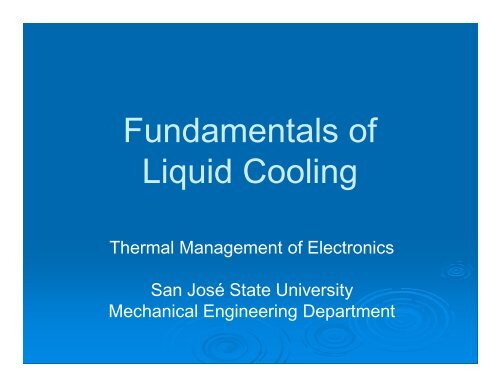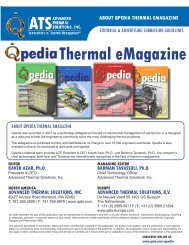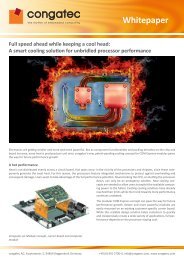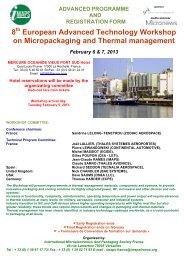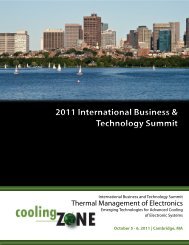Heat Transfer in Microchannels - coolingZONE
Heat Transfer in Microchannels - coolingZONE
Heat Transfer in Microchannels - coolingZONE
You also want an ePaper? Increase the reach of your titles
YUMPU automatically turns print PDFs into web optimized ePapers that Google loves.
Fundamentals of<br />
Liquid Cool<strong>in</strong>g<br />
Thermal Management of Electronics<br />
San José State University<br />
Mechanical Eng<strong>in</strong>eer<strong>in</strong>g Department
Simplicity<br />
Low Cost<br />
PROS:<br />
Easy to Ma<strong>in</strong>ta<strong>in</strong><br />
Reliable<br />
Air as a Coolant<br />
CONS:<br />
Inefficient at heat<br />
removal<br />
(low k and Pr)<br />
Low thermal<br />
capacitance (low ρ<br />
and C p)<br />
Large thermal<br />
resistance
Us<strong>in</strong>g Alternate Coolants<br />
As electronic components get smaller and<br />
heat transfer requirements <strong>in</strong>crease air<br />
becomes a less efficient coolant<br />
Liquid cool<strong>in</strong>g provides a means <strong>in</strong> which<br />
thermal resistance can be reduced<br />
dramatically
Indirect –<br />
Types of Liquid Cool<strong>in</strong>g<br />
The coolant does not come <strong>in</strong>to<br />
contact with the electronics.<br />
Direct (Immersion) –<br />
The coolant is <strong>in</strong> direct contact with the<br />
electronics.
Fluid Selection<br />
Is the fluid <strong>in</strong> direct contact with the<br />
electronics?<br />
No. Water will normally be used due to the<br />
fact that it is cheap and has superior thermal<br />
properties.<br />
Yes. A dielectric must be used. Consideration<br />
must be given to the thermal properties of<br />
different dielectric fluids.
<strong>Microchannels</strong><br />
<strong>Microchannels</strong> are most commonly used<br />
for <strong>in</strong>direct liquid cool<strong>in</strong>g of IC’s and may<br />
be:<br />
Mach<strong>in</strong>ed <strong>in</strong>to the chip itself.<br />
Mach<strong>in</strong>ed <strong>in</strong>to a substrate or a heat s<strong>in</strong>k and<br />
then attached to a chip or array of chips.
Example: Thermal<br />
Conduction Module<br />
used on IBM<br />
3080X/3090 series<br />
<strong>Heat</strong> is transmitted<br />
through an<br />
<strong>in</strong>termediate structure<br />
to a cold plate<br />
through which a<br />
coolant is pumped<br />
<strong>Microchannels</strong><br />
Incropera, pg. 3
R th,h – Conduction Resistance<br />
through the chip<br />
R th,c – Contact Resistance at<br />
the Chip/Substrate Interface<br />
<strong>Microchannels</strong><br />
Incropera, pg. 155<br />
R th,sub – 3-D Conduction<br />
Resistance <strong>in</strong> the substrate<br />
(spread<strong>in</strong>g resistance)<br />
R th,cnv – Convection<br />
Resistance from the substrate<br />
to the coolant<br />
Note that this network ends with the mean fluid temperature. If we use the<br />
<strong>in</strong>let fluid temperature, we also need to <strong>in</strong>clude R caloric
Motivat<strong>in</strong>g Example<br />
Lam<strong>in</strong>ar flow through a rectangular channel:<br />
Kandlikar and Grande, pg. 7 Kandlikar and Grande, pg. 8
Pressure Drop <strong>in</strong> <strong>Microchannels</strong><br />
The pressure drop due to forc<strong>in</strong>g a fluid<br />
through a small channel may produce<br />
design limitations.<br />
V is the mean flow velocity<br />
L is the flow length<br />
ρ is the fluid density<br />
f is the friction factor, depends on<br />
the aspect ratio.<br />
Limitations may <strong>in</strong>clude:<br />
1)Pump<strong>in</strong>g Power<br />
2)Mechanical Stress<br />
Limitation of the Chip<br />
Material
Pressure Drop Example<br />
If chip power<br />
<strong>in</strong>creases mass flow<br />
rate must <strong>in</strong>crease<br />
If mass flow rate<br />
<strong>in</strong>creases pressure<br />
drop <strong>in</strong>creases<br />
Kandlikar and Grande, pg. 9
Optimization of <strong>Microchannels</strong><br />
Kandlikar and Grande, pg. 9<br />
How should the channels <strong>in</strong> the silicon substrate<br />
be designed for optimal heat transfer? Should<br />
the channel be deep or shallow? Make sure to<br />
give a valid reason.
Optimization of <strong>Microchannels</strong><br />
Kandlikar and Grande, pg. 9<br />
The channels should be deep so that the<br />
hydraulic diameter is small but the channel<br />
surface area is large.<br />
Caution: Mak<strong>in</strong>g the channels too small<br />
may result <strong>in</strong> unreasonable pressure drop.
Microchannel Issues<br />
Liquids + Electronics<br />
Self-explanatory<br />
Foul<strong>in</strong>g Lead<strong>in</strong>g to Clogg<strong>in</strong>g<br />
Clogg<strong>in</strong>g prevents flow of liquids through a<br />
channel<br />
Local areas where heat is not pulled away<br />
from components at a high enough rate are<br />
developed
M<strong>in</strong>i-Pumps<br />
Microchannel Issues<br />
Able to move liquid through the channel at a<br />
required rate<br />
Able to produce large pressure heads to<br />
overcome the large pressure drop associated<br />
with the small channels<br />
Tradition rotary pumps can not be used due to<br />
their large size and power consumption<br />
For <strong>in</strong>formation on some current solutions<br />
refer to<br />
http://www.electronics-cool<strong>in</strong>g.com/html/2006_may_a3.html
Current Research for S<strong>in</strong>gle Phase<br />
Convection <strong>in</strong> <strong>Microchannels</strong><br />
Surface Area<br />
Add<strong>in</strong>g protrusions to the channels to<br />
<strong>in</strong>crease surface area.<br />
Add<strong>in</strong>g and arrang<strong>in</strong>g f<strong>in</strong>s <strong>in</strong> a manner that is<br />
similar to a compact heat exchanger.<br />
Microstructures<br />
Silicon<br />
Substrate<br />
Examples of different geometries:<br />
• Staggered F<strong>in</strong>s<br />
•Posts<br />
Kandlikar and Grande, pg. 10<br />
•T-Shaped F<strong>in</strong>s
Current Research for S<strong>in</strong>gle Phase<br />
Convection <strong>in</strong> <strong>Microchannels</strong><br />
Manufactur<strong>in</strong>g Technology<br />
Reduc<strong>in</strong>g cost of manufactur<strong>in</strong>g<br />
Produc<strong>in</strong>g enhanced geometries<br />
For further <strong>in</strong>formation refer to article by<br />
Kandlikar and Grange
Current Research for S<strong>in</strong>gle Phase<br />
Convection <strong>in</strong> <strong>Microchannels</strong><br />
Justify<strong>in</strong>g deviation from classical theory<br />
for friction and heat transfer coefficients<br />
when microchannel diameters become<br />
small<br />
Lack of a good analytical model<br />
Surface Roughness<br />
Accurate measurements of system<br />
parameters<br />
Ect.<br />
***If you are <strong>in</strong>terested <strong>in</strong> this take a look at:<br />
Palm, B. “<strong>Heat</strong> <strong>Transfer</strong> <strong>in</strong> <strong>Microchannels</strong>”. Microscale Thermophysical Eng<strong>in</strong>eer<strong>in</strong>g 5:155-175,<br />
2001. Taylor Francis, 2001.
Benefits of us<strong>in</strong>g a jet <strong>in</strong><br />
thermal management of<br />
a surface:<br />
Jet Imp<strong>in</strong>gement<br />
A th<strong>in</strong> hydrodynamic<br />
boundary layer is formed<br />
A th<strong>in</strong> thermal boundary<br />
layer is formed<br />
Incropera, pg. 56
Classify<strong>in</strong>g Imp<strong>in</strong>g<strong>in</strong>g Jets<br />
Jets can be:<br />
Free-Surface –<br />
discharged <strong>in</strong>to an<br />
ambient gas<br />
Submerged –<br />
discharged <strong>in</strong>to a liquid<br />
of the same type<br />
Cross Sections:<br />
Circular<br />
Rectangular<br />
Conf<strong>in</strong>ement:<br />
Conf<strong>in</strong>ed – Flow is<br />
conf<strong>in</strong>ed to a region<br />
after imp<strong>in</strong>gement<br />
Unconf<strong>in</strong>ed – Flow is<br />
unconf<strong>in</strong>ed after<br />
imp<strong>in</strong>gement
Classify the Follow<strong>in</strong>g Jets<br />
Incropera, pg. 56<br />
Incropera, pg. 65<br />
Liquid jet released<br />
<strong>in</strong>to ambient gas<br />
Liquid release <strong>in</strong>to<br />
liquid of the same<br />
type
Classify the Follow<strong>in</strong>g Jets<br />
Incropera, pg. 56<br />
Incropera, pg. 65<br />
Unconf<strong>in</strong>ed, circular,<br />
free-surface jet<br />
Unconf<strong>in</strong>ed, circular,<br />
submerged jet
Nozzle Design<br />
Nozzles are designed to create different jet<br />
characteristics<br />
Example: Sufficiently long nozzles will produce both<br />
fully developed lam<strong>in</strong>ar or turbulent jets (Shown <strong>in</strong> b)<br />
Incropera, pg. 58
Flow Regions<br />
Stagnation Region – Jet<br />
flow is decelerated normal<br />
to the imp<strong>in</strong>gement<br />
surface and accelerated<br />
parallel to it.<br />
Hydrodynamic and<br />
thermal boundary layers<br />
are uniform.<br />
Wall Jet Region –<br />
Boundary layers beg<strong>in</strong> to<br />
grow<br />
Incropera, pg. 62
Degradation of <strong>Heat</strong> <strong>Transfer</strong><br />
Dur<strong>in</strong>g Jet Imp<strong>in</strong>gement<br />
Splatter<strong>in</strong>g – Droplets are eject from the<br />
wall jet region due to the distance the<br />
nozzle is from the heat source and the<br />
surface tension of the jet fluid<br />
Hydraulic Jump – An abrupt <strong>in</strong>crease <strong>in</strong><br />
film thickness and reduction <strong>in</strong> film velocity<br />
occurr<strong>in</strong>g <strong>in</strong> the wall jet region
Conf<strong>in</strong><strong>in</strong>g Fluid Flow<br />
Add<strong>in</strong>g a conf<strong>in</strong><strong>in</strong>g<br />
wall:<br />
Adds low and high<br />
pressure regions<br />
Sometimes adds<br />
secondary stagnation<br />
regions<br />
Degrades convection<br />
heat transfer<br />
Decreases space<br />
needed to use jet<br />
imp<strong>in</strong>gement<br />
Incropera, pg. 69
Two-Phase Boil<strong>in</strong>g <strong>in</strong><br />
<strong>Microchannels</strong><br />
Fluid enter<strong>in</strong>g microchannels is heated to<br />
the po<strong>in</strong>t where it boils<br />
Flow <strong>in</strong> microchannels is highly<br />
unpredictable and can produce large voids<br />
and multiple flow regimes <strong>in</strong>side of tubes<br />
No accurate analytical models currently<br />
exist; many analytical models have errors<br />
rang<strong>in</strong>g from 10% to well over 100%
Flow Regimes <strong>in</strong> Two-Phase<br />
Applications<br />
Garimella, pg. 107
Immersion (Direct) Cool<strong>in</strong>g<br />
In direct cool<strong>in</strong>g electronics are immersed<br />
<strong>in</strong>to a dielectric liquid<br />
Closed loop systems are normally used<br />
due to both the cost of the liquids used<br />
and the environmental issues associated<br />
with the liquids escap<strong>in</strong>g <strong>in</strong>to the<br />
atmosphere
Typical Liquids Used <strong>in</strong> Immersion<br />
Cengel, pg. 920
Boil<strong>in</strong>g Used <strong>in</strong> Immersion<br />
Cengel, pg. 918<br />
Electronics expel heat <strong>in</strong>to the liquid<br />
Vapor bubbles are formed <strong>in</strong> the liquid<br />
The vapor is collected at the top of the enclosure where<br />
it comes <strong>in</strong> contact with some sort of heat exchanger<br />
The vapor condenses and returns to the liquid portion of<br />
the reservoir
Boil<strong>in</strong>g Used <strong>in</strong> Immersion<br />
Cengel, pg. 919<br />
Electronics dissipate heat through the liquid<br />
Vapor bubbles are generated<br />
As vapor bubbles rise they come <strong>in</strong> contact with the<br />
cooler liquid produced by an immersed heat exchange<br />
and they implode<br />
*The prior example is more efficient due to the heat transfer<br />
coefficient associated with condensation
Cray-2 Supercomputer<br />
Cold fluid enters between<br />
the circuit modules<br />
Convection occurs, pull<strong>in</strong>g<br />
heat from the electronics to<br />
the liquid<br />
The heated fluid is pumped<br />
to a heat exchanger<br />
<strong>Heat</strong> is transfer from the<br />
immersion liquid to chilled<br />
water <strong>in</strong> the heat exchanger Incropera, pg. 6
Concerns with Immersion<br />
Introduction of <strong>in</strong>compressible gasses <strong>in</strong>to<br />
a vapor space<br />
This will limit the amount of condensation that<br />
is allowed to occur and degrade heat transfer<br />
Leakage<br />
Environmental Concerns<br />
Reliability
Sources<br />
Cengel, Yunus A. <strong>Heat</strong> <strong>Transfer</strong>: A Practical Approach. 1 st edition. New York, NY:<br />
McGraw Hill. 1998<br />
Incropera, Frank P. Liquid Cool<strong>in</strong>g of Electronic Devices by S<strong>in</strong>gle Phase Convection.<br />
Danvers, MA: John Wiley & Son. 1999<br />
Kandlikar, Satish G. and Grande, William J. “Evaluation of S<strong>in</strong>gle Phase Flow <strong>in</strong><br />
<strong>Microchannels</strong> for High <strong>Heat</strong> Flux Chip Cool<strong>in</strong>g – Thermohydrolic Performance<br />
Enhancement and Fabrication Technology”. <strong>Heat</strong> <strong>Transfer</strong> Eng<strong>in</strong>eer<strong>in</strong>g. Taylor<br />
Francis Inc. 25(8). 2004<br />
Palm, Bjorn. “<strong>Heat</strong> <strong>Transfer</strong> <strong>in</strong> <strong>Microchannels</strong>”. Microscale Thermophysical<br />
Eng<strong>in</strong>eer<strong>in</strong>g 5:155-175, 2001. Taylor Francis, 2001.<br />
Kandlikar, Satish G. and Grande, William J. “Condensation Flow Mechanisms <strong>in</strong><br />
<strong>Microchannels</strong>: Basis for Pressure Drop and <strong>Heat</strong> <strong>Transfer</strong> Models”. <strong>Heat</strong> <strong>Transfer</strong><br />
Eng<strong>in</strong>eer<strong>in</strong>g. Taylor Francis Inc. 25(3). 2004


